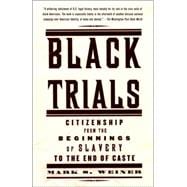
Note: Supplemental materials are not guaranteed with Rental or Used book purchases.
Purchase Benefits
What is included with this book?
| Preface Introduction: Rituals of Citizenship | |
| Colonial Visions, 1619-1773 The Birth of Black Trials | |
| Let Us Make a Tryal (Joseph Hanno and Cotton Mather, Boston, 1721) | |
| This Villainous Conspiracy (The Great Negro Plot, New York, 1741) | |
| Air Too Pure (Somerset's Case,London, 1772) | |
| White Republic, 1776-1849 National Identity on Trial | |
| I Should Not Turn Her Out (Crandall v. Connecticut,Hartford, 1833) | |
| All We Want Is Make Us Free (The Amistad,Washington, 1841) | |
| Christian Witness (Jones v. Van Zandt,Cincinnati, 1847) | |
| New Americans, 1850-1896 Fulcrum | |
| The Law of Blood (John Brown, Virginia, 1859) | |
| Original Purity (The Ku Klux Klan Trials, South Carolina, 1871) | |
| In the Nature of Things (The Civil Rights Cases,California, 1883, and Plessy v. Ferguson,Louisiana, 1896) | |
| Uplift the Race, 1903-1970 Overcoming Jim Crow | |
| Black, White, and Red (The Scottsboro Boys, Alabama, 1931) | |
| Hearts and Minds (Brown v. Board of Education,Kansas, 1954) | |
| To Die for the People (Huey Newton, California, 1968) | |
| After Caste, 1991-2004 Passage | |
| Confirmation (Anita Hill and Clarence Thomas, Washington, 1991) | |
| Statistics and Citizenship (Mumia Abu-Jamal, Philadelphia, 2001) | |
| Coda Notes | |
| Index | |
| Table of Contents provided by Publisher. All Rights Reserved. |
The New copy of this book will include any supplemental materials advertised. Please check the title of the book to determine if it should include any access cards, study guides, lab manuals, CDs, etc.
The Used, Rental and eBook copies of this book are not guaranteed to include any supplemental materials. Typically, only the book itself is included. This is true even if the title states it includes any access cards, study guides, lab manuals, CDs, etc.
Excerpted from Black Trials: Citizenship from the Beginnings of Slavery to the End of Caste by Mark S. Weiner
All rights reserved by the original copyright owners. Excerpts are provided for display purposes only and may not be reproduced, reprinted or distributed without the written permission of the publisher.